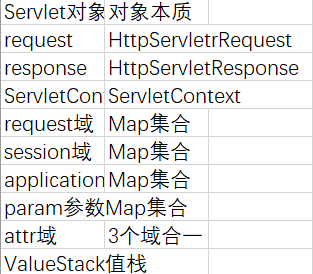1、ActionContext对象方式
(1)ActionContext对象的作用:
ActionContext对象是Struts2的一个内置对象,通过该对象可以获得Servlet的对象,如:request、response等,ActioContext对象本质上是一个Map集合。
(2)ActionContext中常见的对象

其中,attr域是request域、response域和application域,三个域的累计。
(3)生命周期:
每次请求都会创建一个ActionContext对象,请求处理结束该ActionContext对象销毁,其他的如:request、response的生命周期和以前一样。
(4)ActionContext对象的获取
ActionContext对象创建之后会与当前线程进行绑定,一个线程有一个唯一的ActionContext,因此,我们可以从ThreadLocal中获取ActionContext对象。
2、ActionContext方式:域对象值的设定与取出
(1)对每个域设定值:
public class ApiAction extends ActionSupport {
public String execute() {
Map<String,Object> requestScope= (Map<String, Object>) ActionContext.getContext().get("request");
requestScope.put("name","我是用常规的方式来获得request域");
ActionContext.getContext().put("name","我是用ActionContext的方式来获得request域");
Map<String,Object> sessionScope=ActionContext.getContext().getSession();
sessionScope.put("name","我是通过ActionContext的方式来获得的session域");
Map<String,Object> applicationScope=ActionContext.getContext().getApplication();
applicationScope.put("name","我是通过ActionContext的方式来获得的application域");
return "success";
}
}
其中request域的获取有两种方法,但是第一种方法较为复杂较少使用,第二种方法为获得ActionContext域,因为两个域的生命周期相同,效果也是一样的。
(2)从域中取值:
<body>
${requestScope.name}<br>
${request.name}<br>
${sessionScope.name}<br>
${applicationScope.name}<br>
</body>
3、ServletActionContext对象
(1)获取原生的servlet对象
public String execute() {
HttpServletRequest request=ServletActionContext.getRequest();
HttpSession session=request.getSession();
HttpServletResponse response=ServletActionContext.getResponse();
ServletContext servletContext=ServletActionContext.getServletContext();
return "success";
}
(2)生命周期
ServletActionContext类直接继承了ActionContext类,两者的生命周期相同。
public class ServletActionContext extends ActionContext implements StrutsStatics {
4、继承接口的方式
public class ApiAction extends ActionSupport implements ServletRequestAware, ServletResponseAware {
private HttpServletRequest httpServletRequest;
private HttpServletResponse httpServletResponse;
public String execute() {
return "success";
}
@Override
public void setServletRequest(HttpServletRequest httpServletRequest) {
this.httpServletRequest=httpServletRequest;
}
@Override
public void setServletResponse(HttpServletResponse httpServletResponse) {
this.httpServletResponse=httpServletResponse;
}
}
即获取一个对象就要实现一个相应的接口。
5、总结
较为常用的是第一种方式,后两种方式都是在第一种方式之上建立的。
